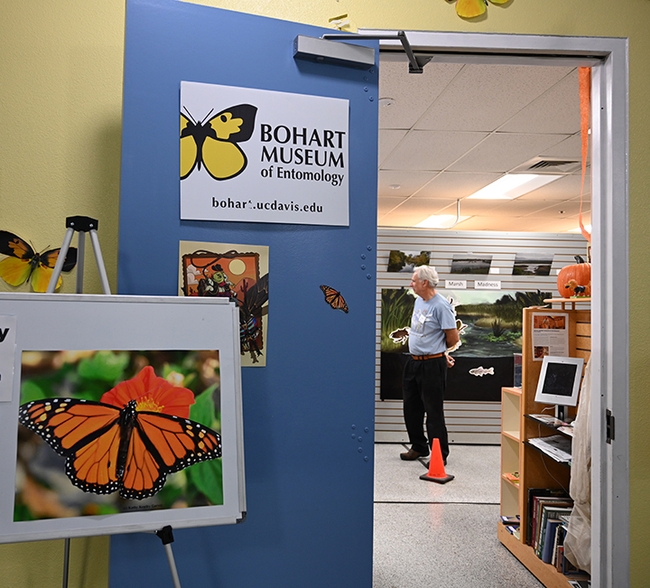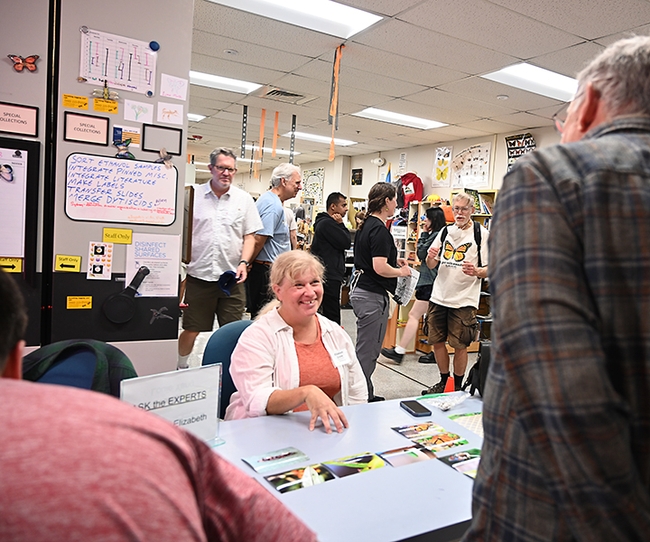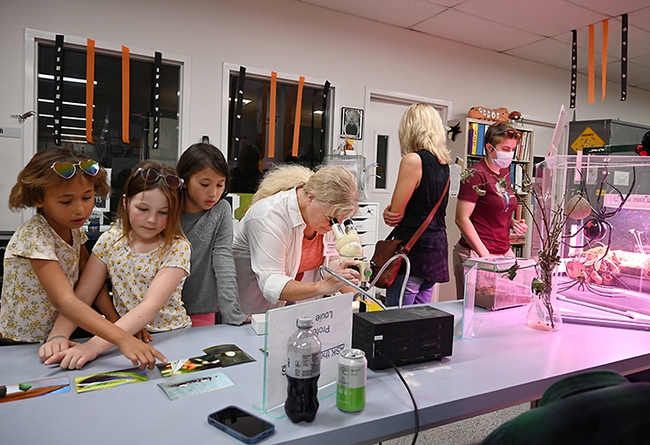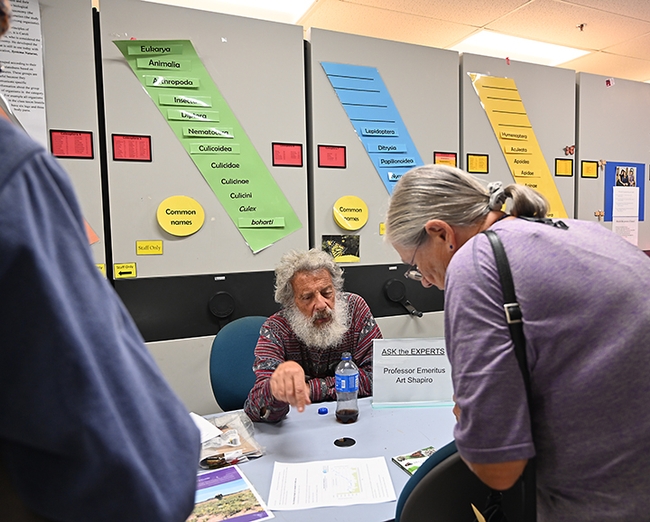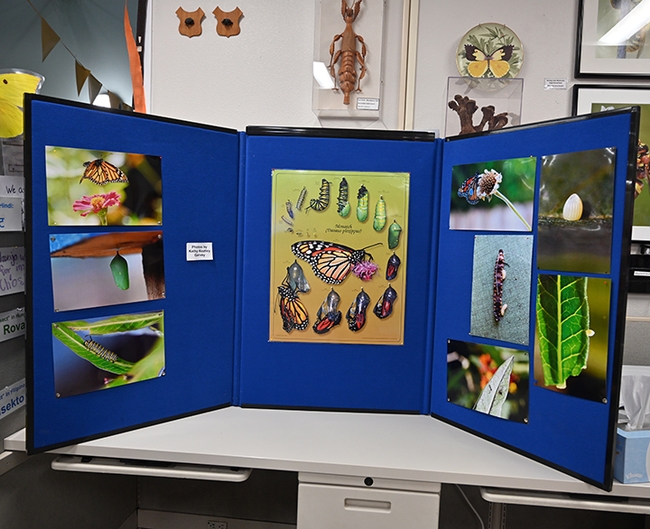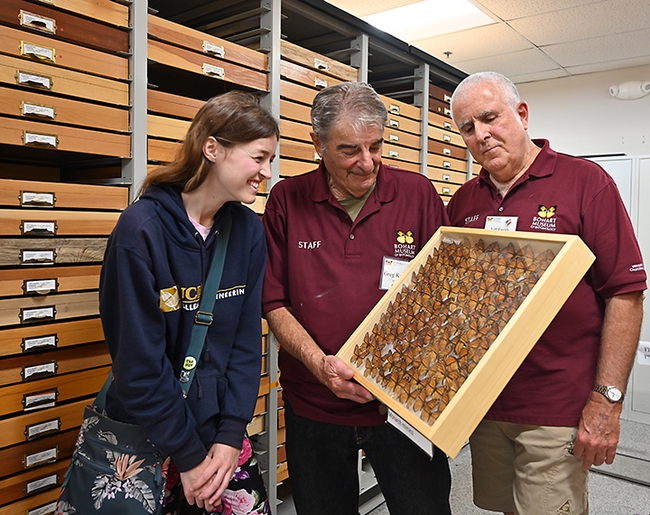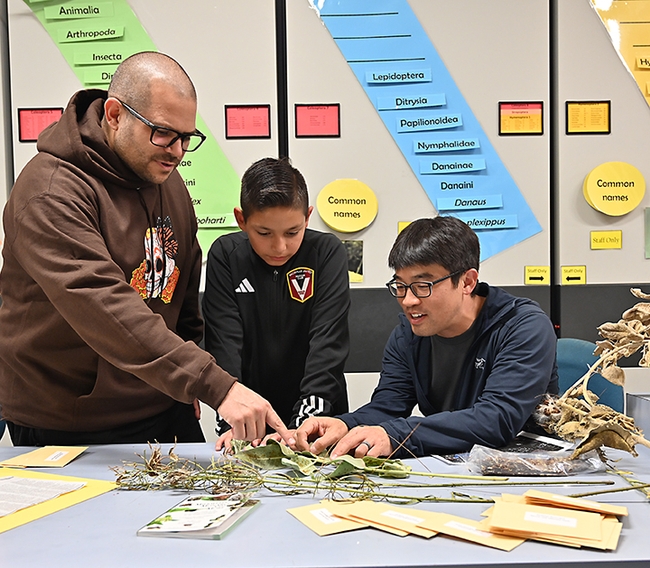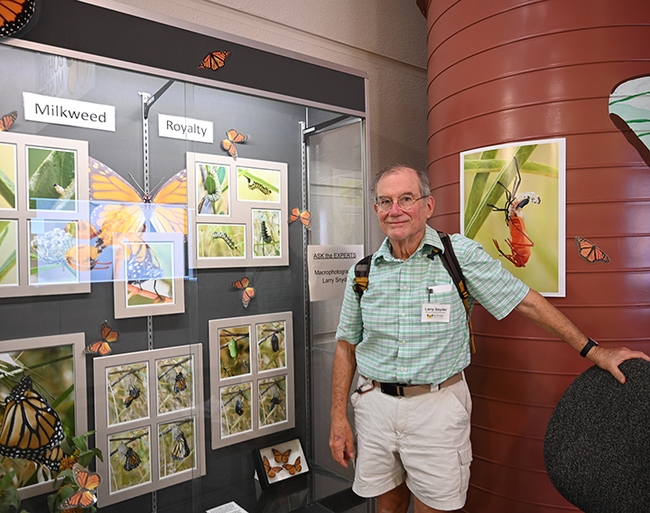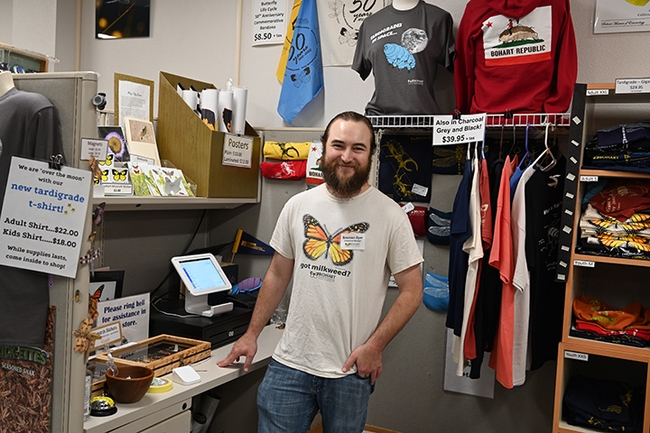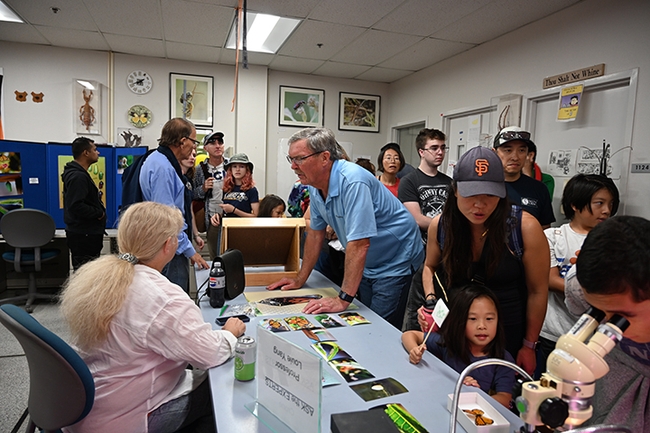- Author: Kathy Keatley Garvey
Monarch butterflies seem to be as scarce as hen's teeth around here.
And since hens have no teeth, that's pretty scarce.
And then it happened.
A late in-star monarch caterpillar appeared on our milkweed in our Vacaville pollinator-predator garden on the very last day of July.
We watched it munch the wilting milkweed leaves in the triple-digit temperature.
For one day.
The next day, Aug. 1, it vanished, never to be seen again. Did it pupate? Did the California scrub jays get it?
The scrub jays nesting in our cherry laurel hedges are prime suspects. They devour everything in the garden, from honey bees, longhorned bees and dragonflies to assorted butterflies, lygus bugs and praying mantises. Happy meals. If they eat a monarch caterpillar, that makes for an unhappy meal, the vomiting kind. It's about the naturally occurring toxins (cardiac glycosides) in the milkweed that the 'cats ingest that serve as predatory protection. That's why scientists say "I bet you'll eat only one."
Just one. The one we were watching?
"Known bird predators include brown thrashers, grackles, robins, cardinals, sparrows, scrub jays and pinyon jays," Wikipedia says, but notes that "Several species of birds have acquired methods that allow them to ingest monarchs without experiencing the ill effects associated with the cardiac glycosides (cardenolides). The black-backed oriole is able to eat the monarch through an exaptation of its feeding behavior that gives it the ability to identify cardenolides by taste and reject them. The black-headed grosbeak, though, has developed an insensitivity to secondary plant poisons that allows it to ingest monarchs without vomiting. As a result, these orioles and grosbeaks periodically have high levels of cardenolides in their bodies, and they are forced to go on periods of reduced monarch consumption. This cycle effectively reduces potential predation of monarchs by 50% and indicates that monarch aposematism has a legitimate purpose. The black-headed grosbeak has also evolved resistance mutations in the molecular target of the heart poisons, the sodium pump. The specific mutations that evolved in one of the grosbeak's four copies of the sodium pump gene are the same as those found in some rodents that have also evolved to resist cardiac glycosides."
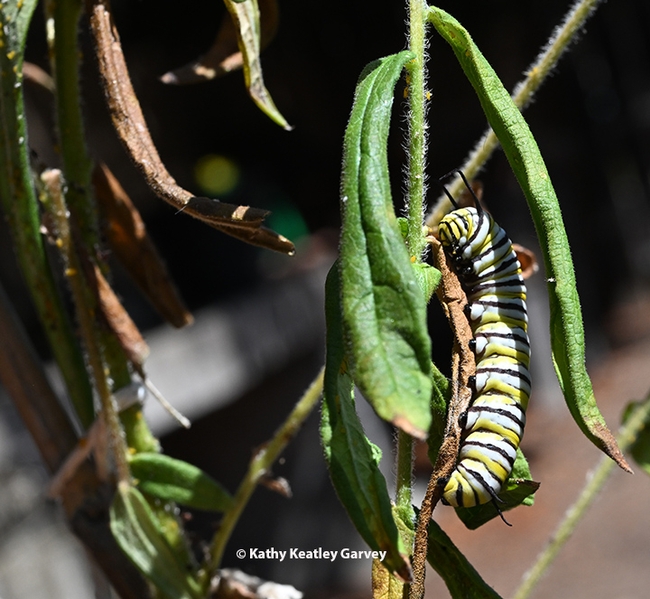
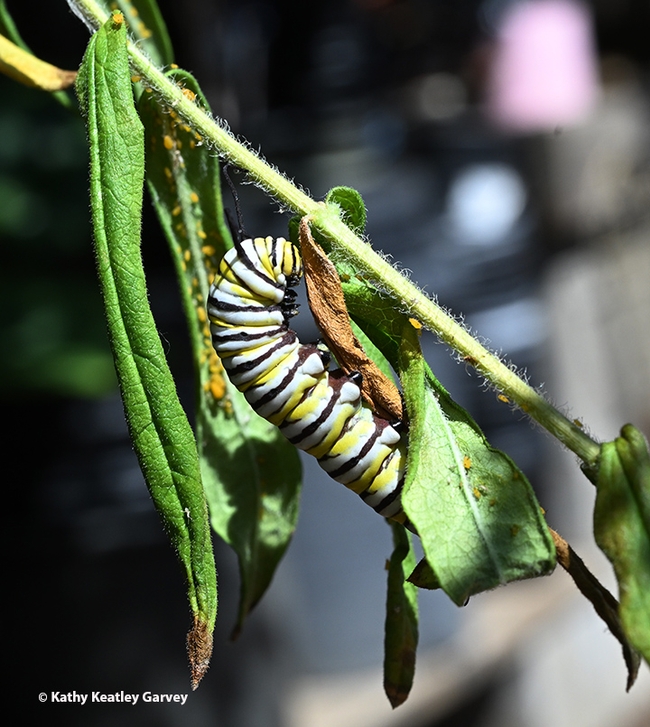
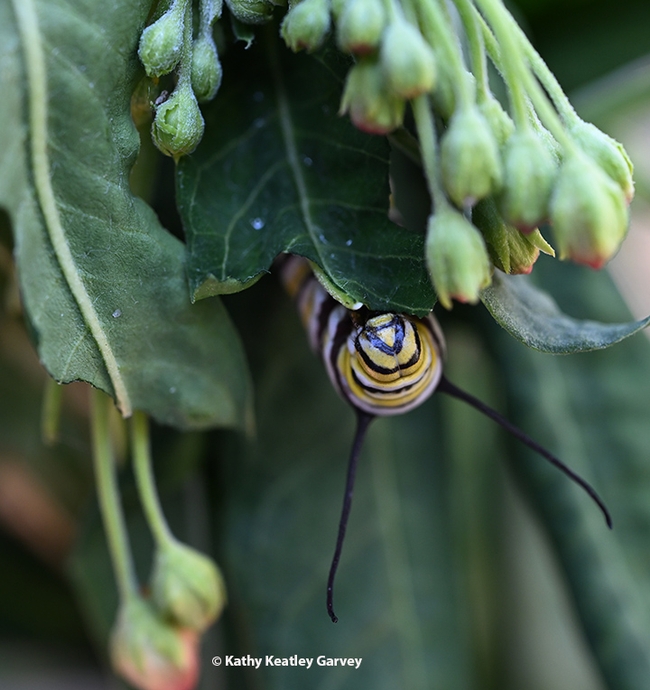
- Author: Kathy Keatley Garvey
So here's this immature praying mantis, a Stagmomantis limbata, perched on a narrow-leafed milkweed, Asclepias fascicularis, in a Vacaville pollinator garden.
She's camouflaged quite well. She's as green and thin as the leaves.
Me: "Hey, Ms. Mantis, whatcha doin'?"
Ms. Mantis: "Just occupying a spot on this milkweed. Catching some sun, is all."
Me: "Hoping to catch a monarch, Ms. Mantis?"
Ms. Mantis: "No, no, of course not. I would never, ever, catch a monarch! You know me!"
Me: "I do know you. Promise you won't nail a monarch?"
Ms. Mantis: "Sorry, I can't promise if I'm hungry. Now, go away, you're disrupting my choice of menu items."
Me: "How about a stink bug or a lygus bug?"
Ms. Mantis: "I don't take menu orders. What do you think I am? DoorDash? Go away!"
Me: "Hey, I see a katydid nymph over there!"
Ms. Mantis: "Where, where? How far?"
Me: (Pointing to a lower leaf) "Over there!"
With that, Ms. Mantis slipped off the blossom, never to be seen again.
Epilogue: The California scrub jays noisily nesting in the cherry laurel hedges may have snagged a Stagmomantis mantis meal.
They don't take orders, either.
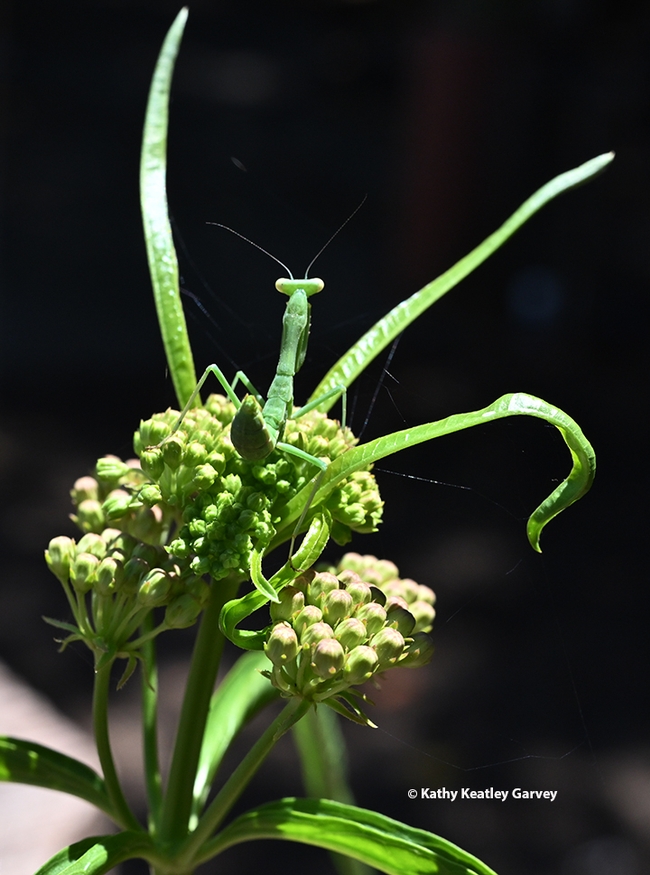
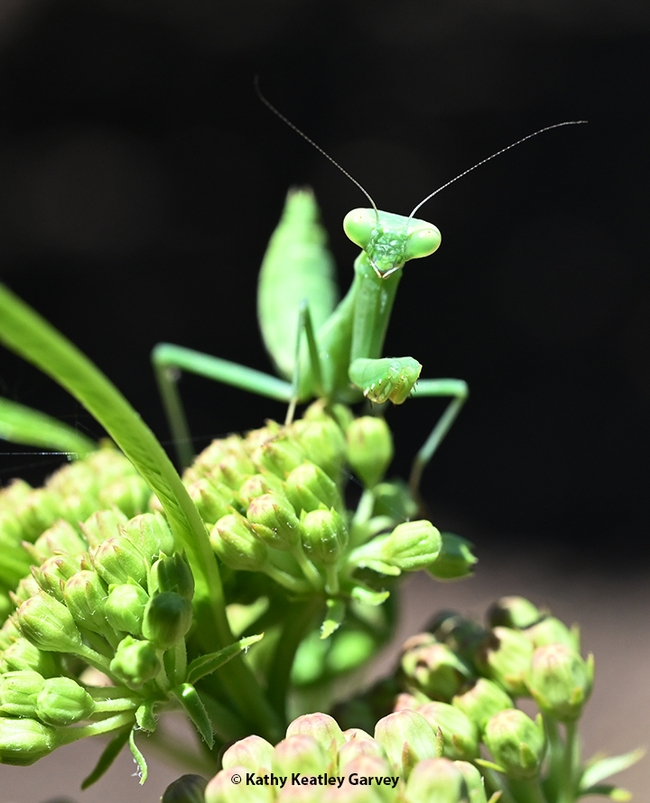
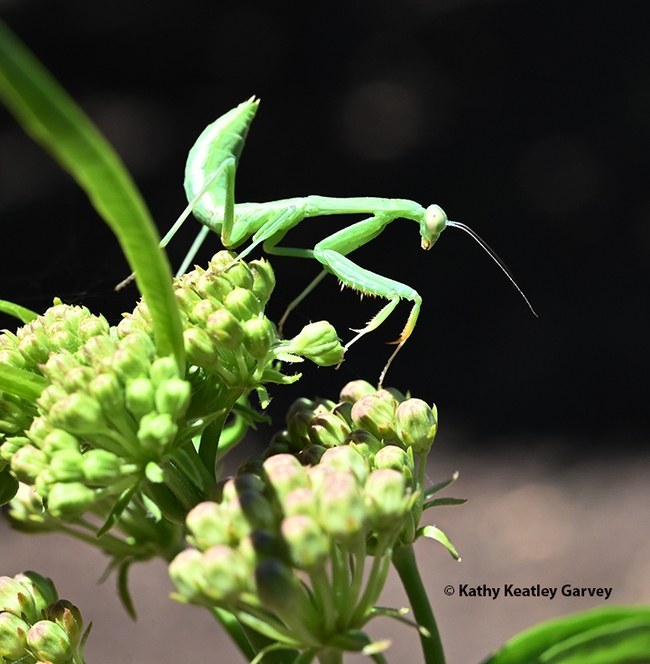
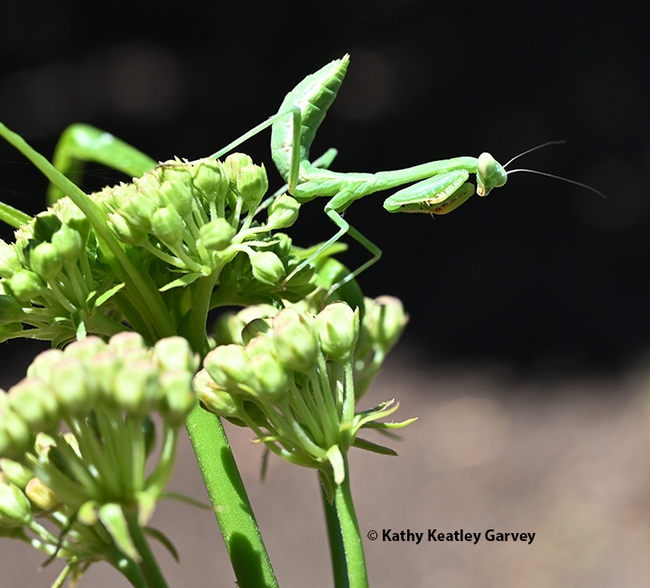
- Author: Kathy Keatley Garvey
Professor Louie Yang's monarch and milkweed research at the University of California, Davis, is quite celebrated.
Yang, a community ecologist and professor in the Department of Entomology and Nematology, is involved in monarch conservation science and planning, in collaboration with the Western Monarch Conservation Science Group, U.S. Fish and Wildlife Service, the Xerces Society of Invertebrate Conservation, Monarch Joint Venture, Environment Defense Fund, and the National Monarch Summit in D.C.
- Science Friday, National Public Radio, interviewed him in February 2022 about his monarch-milkweed research. (Listen to the archived interview.)
- He was one of 12 invited scientists nationwide who delivered a presentation during the two-day Monarch Butterfly Summit, held in June 2022 at the Capitol, Washington D.C. He has presented invited seminars at Purdue University and the University of Nevada.
Another feat: Yang launched the Monitoring Milkweed-Monarch Interactions for Learning and Conservation (MMMILC) project in 2013 for students in the environmental science program at Davis Senior High School or those associated with the Center for Land-Based Learning's Green Corps program. He taught more than 150 high school-aged participants. Their tasks: monitoring milkweed-monarch interactions in a project funded by the National Science Foundation. He organized and led a 135-member team, and supported them all as co-authors of the paper, “Different Factors Limit Early- and Late-Season Windows of Opportunity for Monarch Development,” published in July 2022 in the journal Ecology and Evolution. The 107 co-authors included high school students, undergraduate and graduate students, and community members.
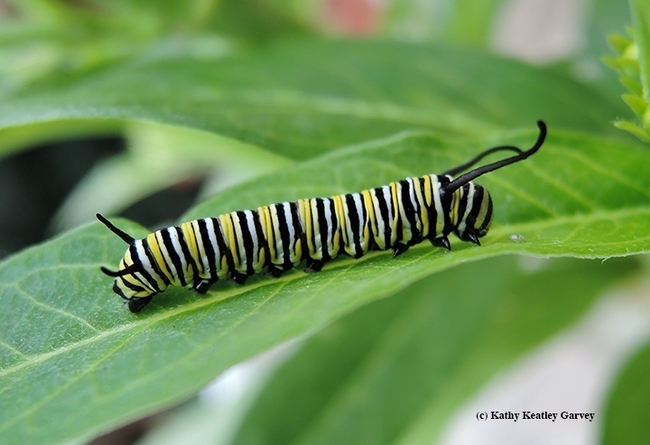
But did you know that Professor Yang excels at teaching and mentoring?
Described as “a phenomenal teacher, mentor and an incredibly strong advocate for students,” Yang is the newly announced recipient of the UC Davis Academic Senate's 2024 Distinguished Teaching Award, Undergraduate Student category.
And so well-deserved.
“I have watched him engage, inspire, and challenge his students, fostering creative and critical thinking like no one else I've ever seen,” Joanna Chiu, professor and chair of the department, wrote in her nomination letter. “We deeply appreciate and admire his innovative and inclusive teaching, his exemplary work ethic, his welcoming demeanor, his dedication to his students, and his nationally recognized ecology expertise. Louie has received many well-deserved teaching and mentoring awards for his teaching contributions on and off campus.”
Professor Yang is one of the three co-founders and co-directors (along with Professor Chiu and UC Davis distinguished professor Jay Rosenheim) of the campuswide, one-of-a-kind Research Scholars Program in Insect Biology (RSPIB), launched in 2011 to help students learn cutting-edge research through close mentoring relationships with faculty.
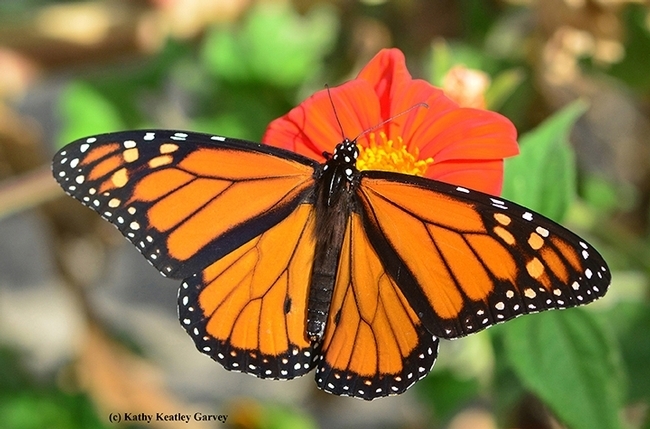
Yang, who holds a bachelor's degree in ecology and evolution (1999) from Cornell University, and a doctorate in population biology (2006) from UC Davis, joined the UC Davis faculty in 2009. UC Davis distinguished professor Walter Leal, then chair of the entomology department, remembers recruiting and hiring him, on the recommendation of community ecologist Richard "Rick" Karban.
In 2012, as an assistant professor, Yang was selected a Hellman Fellow and then received a 2013-2018 National Science Foundation Faculty Early Career Award. In 2015, he won a Chancellor's Teaching Fellow Award and the Atwood Colloquium Rising Star Award in Ecology, University of Toronto. Currently he chairs the Entomology Graduate Program and also serves as interim vice chair while community ecologist and associate professor Rachel Vannette is on sabbatical.
Since 2009, Yang has taught more than 600 undergraduates and more than 90 graduate students in his formal classes. His courses include Insect Ecology, Community Ecology, Experimental Ecology and Evolution in the Field, He has taught two National Science Foundation Graduate Research Fellowship Program (GRFP) grant writing workshops, and the Population Biology Graduate Group core course for three years.

Professor Rosenheim, recipient of the 2011 Academic Senate Distinguished Teaching Award, Undergraduate Level, has observed Yang's innovative teaching. “His class sessions were impeccably organized, his presentations deeply insightful, and the discussions highly engaging," he wrote. "Louie alternated lectures with class sessions in which large blocks of time were devoted to structured debates. For the debates, Louie drew names at random and assembled two 3-person teams of students, one arguing the 'pro' side of the issue, the other arguing the 'con' side. After an initial period when positions were presented and rebuttals given, the whole class was invited to join in the discussion. What was truly remarkable was the high level of participation that Louie is able to elicit, both during the debates and during his lectures. Louie inspires the confidence of his students, and they reciprocate with their willingness to take risks during class by contributing, even when discussing topics that are new to them. This is not an easy thing to accomplish; Louie's ability to gain such strong student participation is perhaps the strongest evidence of Louie's talent in connecting with students. I was so impressed with the success of Louie's methods that I decided to incorporate structured debates into one of my own classes as well."

In unsolicited comments in Rate My Professors, his students wrote:
- “One of the best instructors at UC Davis. Class on insects was very interesting…He is super cool, and lectures are never boring.”
- “Louie honestly might be my favorite professor on campus. He is cool and smart and engaged with his students…”
- “Really one of the most intelligent people I've met in college. It's apparent just talking to him, which I'd highly recommend.”
- “I loved this seminar, Ecology Outdoors! I learned so much from Louie, and he's really good at encouraging creativity and experimentation. He's a very hard worker and plans the class well.”
- “Really cool guy, made the class interesting. gave a lot of real-life example, so students can relate the subject to real world.”
A tip of the insect net to Professor Louie Yang!
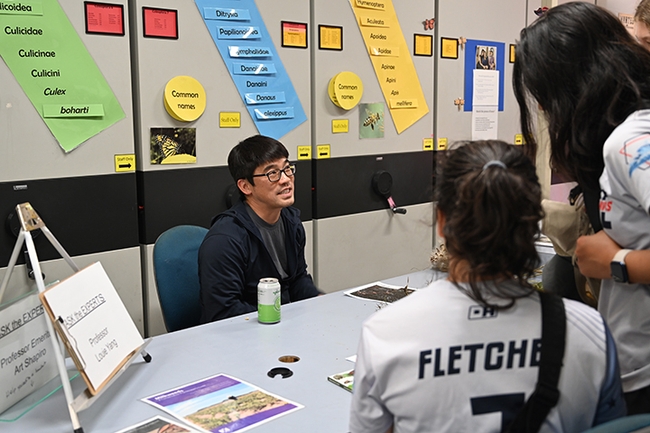
- Author: Kathy Keatley Garvey
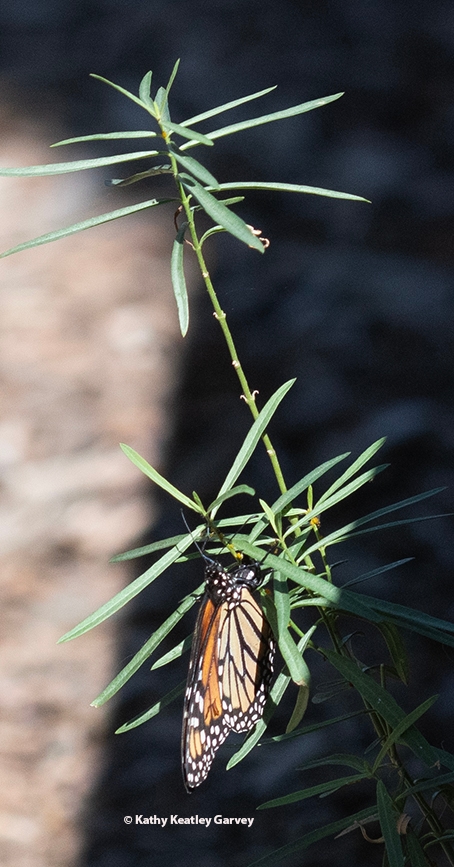
Where do Western monarchs go after leaving their overwintering sites along coastal California in February?
An observation: They didn't stop in the spring or summer to deposit eggs on any of our four species of milkweed in our Vacaville pollinator garden.
Spring? Zero. Zilch. Nada.
Summer? Zero. Zilch. Nada.
Fall? Yes.
Why not spring and summer? Did the monarchs passing through Vacaville opt for "a better habitat" in the cooler Pacific Northwest and beyond (British Columbia)?
"I wish I knew," commented UC Davis distinguished professor emeritus Art Shapiro, who has monitored the butterfly populations of Central California since 1972 and maintains a research website, Art's Butterfly World.
Beginning in September, as many five monarchs a day began fluttering into our garden. Some laid eggs.
To date, we've spotted some 20 eggs and caterpillars.
"This is generally consistent with the pattern we've seen in previous years," said UC Davis Department of Entomology and Nematology professor Louie Yang, who researches monarchs. "Even in Davis, we've been seeing more caterpillars in the late summer/fall. I think this is probably because some are stopping to lay eggs on the return migration, and the fall population is much larger than the spring migration population. Looking very carefully, we did also see eggs in the spring each year, but very few of them developed into large caterpillars." See the Louie Yang et al, research paper, "Different Factors Limit Early- and Late-Season Windows of Opportunity for Monarch Development," published in July 2022 in the journal, Evolution and Ecology.
The availability of food resources, such as tropical milkweed (Asclepias curassavica) that can overwinter in warmer climates, doesn't deter them from migrating, said UC Davis emeritus professor Hugh Dingle of the Department of Entomology and Nematology. Dingle, an internationally known expert on animal migration who has studied monarchs for more than two decades, said: "Migration and the diapause that accompanies it in the fall are determined by shortening photoperiod and temperature (warm temps can override short days hence the issue with climate change)."
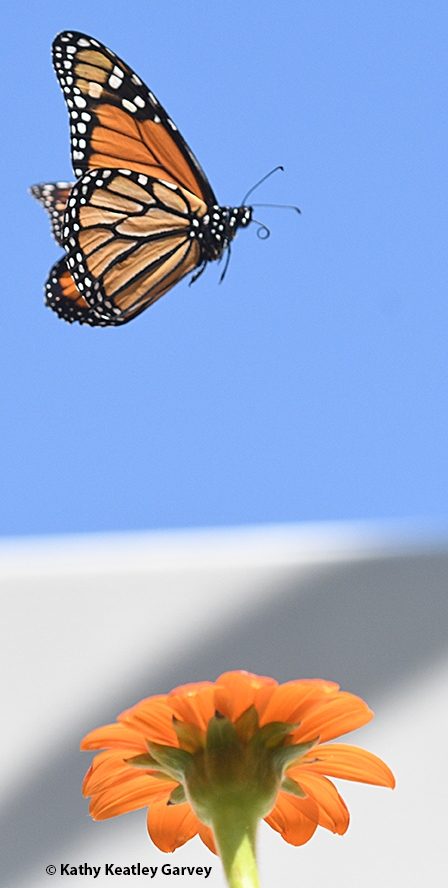
Said UC Davis professor Elizabeth Crone of the Department of Evolution and Ecology: "Monarchs may behave similarly in spring, but the spring population is probably much smaller than the fall one, so they are less likely to happen across your garden. Our estimate is that the population increases 2-3x each generation (so it's about 100-200x larger in Fall than Spring), then resets each year due to mortality during Fall migration and overwintering. There is some research from Sonia Altizer's lab in Georgia showing that monarch butterflies that encounter milkweeds during fall migration will leave reproductive diapause and breed. It is unknown whether these monarchs are effectively lost from the migratory population, or whether they or their offspring (the caterpillars in your yard) will continue on to the overwintering sites."
"The egg-laying females you are seeing now are likely migrants that have eschewed reproductive dormancy for reproduction," says entomologist David James, an associate professor at Washington State University who researches migratory monarchs. "This has probably always happened to some extent but is likely more significant now because of warmer falls."
"The lack of activity in summer in Vacaville was probably a function of most of the population having dispersed further east and north, maybe more than usual? They surely did pass through Vacaville in spring on their way north but clearly didn't stop to use your milkweeds. It does seem that some years they are more prone to frequent stopping/oviposition on their way north and east, yet in others they just keep flying. There's evidence that the latter was the case this year... with as many migrants making it to BC as to Washington... Normally they stop in Washington and only a handful make it to BC."
"The many mysteries of monarchs," James added.
James is the author of a newly published book, The Lives of Butterflies: A Natural History of Our Planet's Butterfly Life (Princeton University) with colleague David Lohman of the City College of New York. The book, released in the UK on Oct. 3, 2023, will be available in the United States starting Jan. 9, 2024.
Irish scientist Éanna Ní Lamhna recently interviewed the WSU entomologist in a podcast on RTÉ, or Raidió Teilifís Éireann. The book, she said, "showcases extraordinary diversity of world's butterflies, while exploring their life histories, behavior, conservation and other aspects of these most fascinating and beguiling insects." (See Bug Squad blog)
Listen to the butterfly podcast here: https://www.rte.ie/radio/radio1/clips/22294525/
Meanwhile, are you seeing fall breeding and egg-laying in your garden? We have for more than a decade, with some monarchs eclosing in November and December.

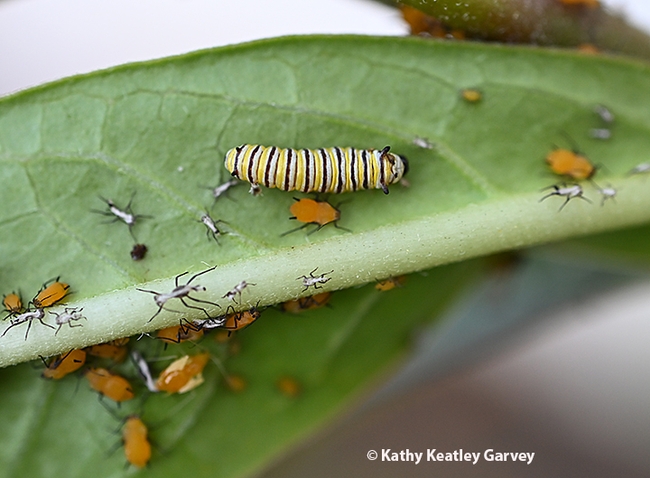
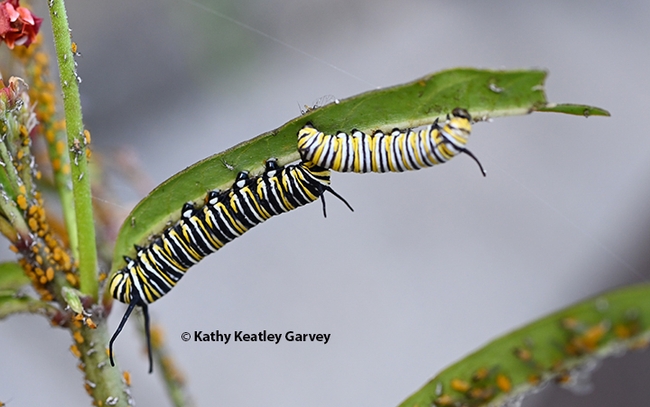
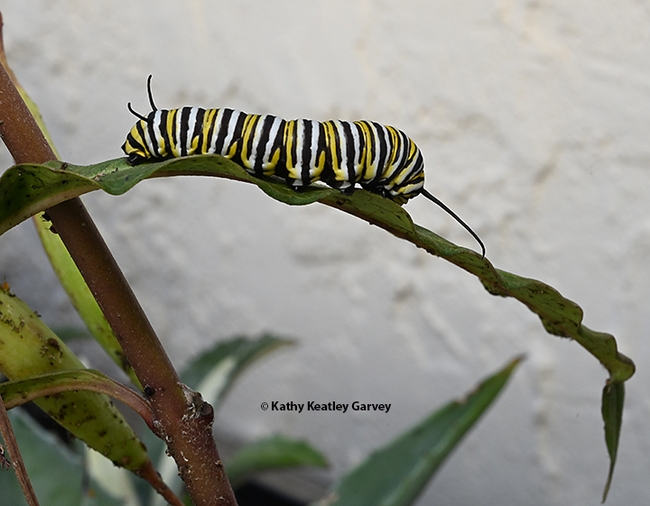

- Author: Kathy Keatley Garvey
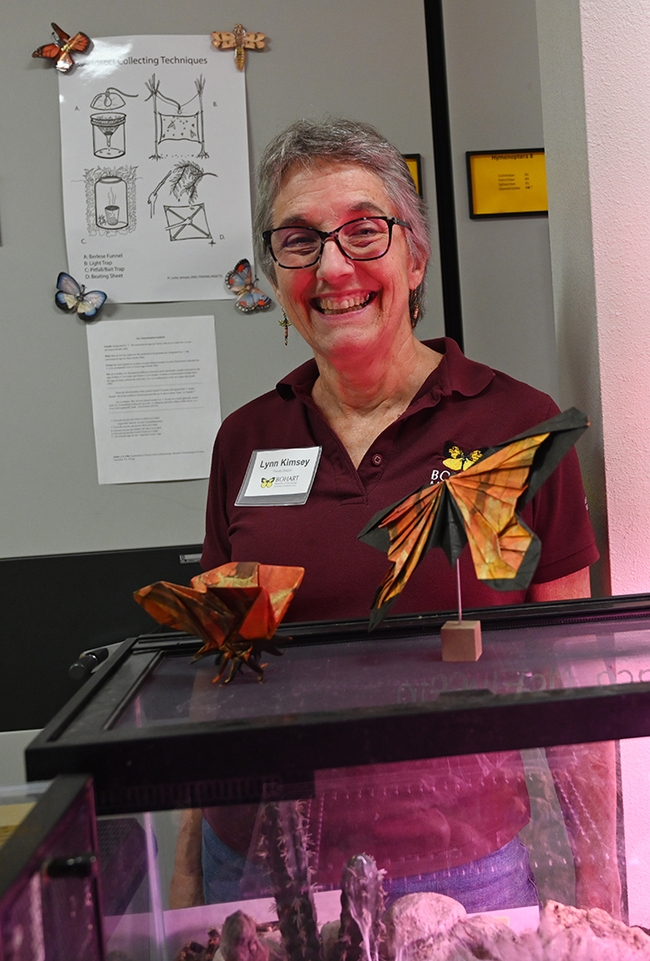
Western monarchs are now settling in their overwintering sites along coastal California, but the iconic butterflies showed up in force at the Bohart Museum of Entomology's recent open house--in the form of specimens, photographs, books, maps and displays.
Some 650 visitors arrived to talk to the scientists, see the displays, and take home native milkweed seed packets, provided by community ecologist Louie Yang, professor of entomology, UC Davis Department of Entomology and Nematology (ENT-NEM). Yang shared seeds of narrow-leafed milkweed, Asclepias fascicularis.
Statistics show that the overwintering population of western monarchs along coastal California has declined by more than 99 percent since the 1980s, according to the Xerces Society for Invertebrate Conservation, but the population has been showing a mini-boom in recent years. Scientists blame habitat destruction, pesticide use, and climate change as the primary causes of the decline.
Scientists participating in the open house were:
- UC Davis distinguished professor emeritus Art Shapiro of the Department of Evolution and Ecology, who has studied butterfly populations in central California since 1972 and maintains a research website, Art's Butterfly World.
- UC Davis emeritus professor Hugh Dingle, a worldwide authority on animal migration, including monarchs. He is the author of Migration: The Biology of Life on the Move (Oxford University Press), a sequel to the first edition published in 1996. (See news story on the ENT-NEM website.)
- UC Davis professor Louie Yang, who does research on monarchs and milkweed and has been featured nationally. (See news story about his work.)
- UC Davis professor Elizabeth Crone of the Department of Evolution and Ecology, formerly of Tufts University, who researches monarchs. (See news story about the declining monarch population on the ENT-NEM website.)
In addition, the Bohart Museum showcased monarch photography by Larry Snyder of Davis and Kathy Keatley Garvey of ENT-NEM.
Yang and Crone were among the 12 nationally invited scientists who delivered presentations during the two-day Monarch Butterfly Summit, held last year at the Capitol in Washington D.C. and organized by Sen. Jeffrey Merkley of Oregon, During that summit, the Department of the Interior announced a $1 million award to the National Fish and Wildlife Foundation's Monarch Butterfly and Pollinators Conservation Fund, and the U.S. Fish and Wildlife Service announced a Pollinator Conservation Center. (See news story)
In another project, Yang organized and led a three-year study of wild monarch butterflies and milkweed in rural Davis. The project, funded by two of Yang's National Science Foundation grants, involved UC Davis, Davis Senior High School and the Center for Land-based Learning, Woodland. The 135-member team included 107 high school students, a K-12 teacher, 18 UC Davis undergraduates, three graduate students and two postgraduate researchers.
"This study collected a high-resolution temporal dataset on milkweed-monarch interactions during the three years prior to the precipitous single-year population decline of western monarchs in 2018,” Yang said. From 2015 through 2017, the team monitored the interactions of monarchs, Danaus plexippus, on narrow-leafed milkweed, A. fascicularis, planted in December 2013 on city-owned property.

“This study has three key findings,” Yang related. “First, we documented early and late seasonal windows of opportunity in the wild, migratory western monarch population. Second, our data suggest that early and late seasonal windows were constrained by different factors. Third, climatic and microclimatic variation had a strong effect on the timing and importance of multiple factors affecting monarch development. Broadly, we hope that this study contributes to a more temporally detailed understanding of the complex factors that contribute to year-to-year variation in monarch breeding success.” (See news story on ENT-NEM website)
In February of 2022, Yang appeared on Science Friday, National Public Radio, in an interview titled "How Long Will California's Butterfly Boom Last?"
Hugh Dingle. Professor Dingle, an internationally known expert on animal migration, has researched animal migration for some 50 years. In the last two decades, he has focused on monarch butterflies. National Geographic featured him in its cover story on “Great Migrations” in November 2010. LiveScience interviewed him for its November 2010 piece on “Why Do Animals Migrate?”
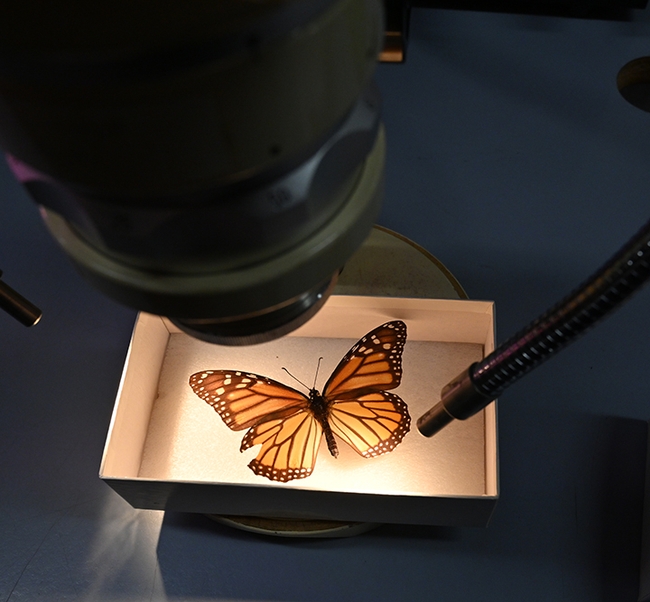
Dingle says:
- "There is not enough tropical milkweed planted to have much influence (see the amount of A. syriaca and A. fascicularis throughout the American West not to mention various other species like A. erosa, cordifolia, californica, etc.) Yes, there are parasites on A. curassavica as there are on ALL milkweeds."
- "There are populations of monarchs that are doing just fine feeding exclusively on A. curassavica (e.g. on many Pacific Islands, such as Guam where I have studied them."
- "Migration and the diapause that accompanies it in the fall are determined by shortening photoperiod and temperature (warm temps can override short days hence the issue with climate change). There is no significant influence of food plant."
Elizabeth Crone. Crone focuses her research on population ecology, "especially of plants and insects, and plant-animal interactions. Specifically, I am interested in how environmental changes translate to changes in population dynamics in animals. I was also one of the first ecologists to use generalized linear mixed models to parameterize stochastic population models." She co-authored "Why Are Monarch Butterflies Declining in the West? Understanding the Importance of Multiple Correlated Drivers," published in 2019 in Ecological Applications, Ecological Society of America.
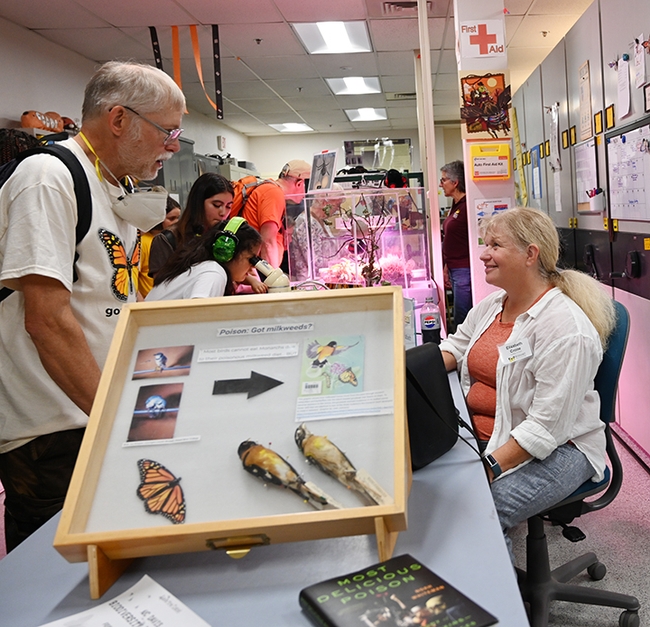
Art Shapiro. Professor Shapiro shared several handouts, including "Comments on Monarchs." He co-authored research (lead author Anne Espeset and six other colleagues) titled, "Understanding a Migratory Species in a Changing World: Climatic Effects and Demographic Declines in the Western Monarch Revealed by Four Decades of Intensive Monitoring," published in Population Ecology.
"None of my group is a Monarch specialist, and that includes me," Shapiro wrote in the handout. "Since 1999 I have done counts of all butterfly species at 4 Valley sites (Suisun, West Sacramento, North Sacramento and Rancho Cordova) using standard 'Pollard walk' methods, slightly modified. As a result we have a quantitative picture of Monarchs in breeding season over 14 years. Such data are very rare. Population estimates of Monarchs are typically based on the overwintering (non-breeding) aggregations and we know from published material that what breeding-season data exist routinely diverge from the overwintering data. That is, trends in population size as measured by overwinter animals are not routinely reflected in the summer numbers. There can be a variety of explanations for this. To me the most likely is that as a very mobile species, the Monarch may breed in different places in different years, so that a monitoring program like mine, based on a limited number of fixed, Intensively-monitored sites, is unlikely to capture this stochasticity in where Monarchs breed."
Over the last 50 years, "Suisun has had the highest counts (of monarchs), partly but not entirely reflecting coastward migration from farther inland early in the season, but these high numbers have effectively disappeared—perhaps reflecting a systematic change in migratory trajectories."
Also at the open house, entomologist Jeff Smith, who curates the Bohart's Lepidoptera collection, and colleague Greg Kareofelas showed visitors drawers of monarch and other butterfly specimens.
Two origami monarchs, the work of UC Davis alumnus Kevin Murakoshi of Davis and a gift to the Bohart Museum, drew special attention. Murakoshi earlier crafted origami praying mantises, ticks and bed bugs for Bohart Museum open houses.
One of the books displayed at the open house was UC Berkeley professor Noah Whiteman's newly published work, "Most Delicious Poison: The Story of Nature's Toxins--from Spices to Vices" (Little Brown Spark, Oct. 24, 2023) It includes information on the toxicity of milkweed.
The Bohart Museum, directed by UC Davis distinguished professor Lynn Kimsey, is located in Room 1124 of the Academic Surge Building, 455 Crocker Lane, UC Davis campus. It is the home of a global collection of eight million insect specimens. It also houses a live "petting zoo" (including Madagascar hissing cockroaches, stick insects and tarantulas) and a gift shop.
